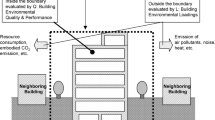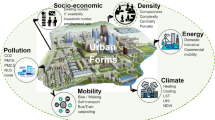Abstract
Integrating state-of-the-art technology is now essential in pursuing environmentally sustainable urban development. This research focuses on Singapore's lush vertical landscape and explores the potential of machine learning. Specifically, Convolutional Neural Networks (CNN) to enhance sustainable urban design. The CNN-MOA model was created by incorporating the Mayfly Optimization Algorithm (MOA) to improve the performance of the CNN-based model further. Without the Mayfly Optimization Algorithm, the convolutional neural network (CNN) achieved impressive results. It had a total accuracy of 0.977725, a weighted average precision of 0.977679, a weighted average recall of 0.977725, a weighted average F1-Score of 0.977621, and a macro average precision of 0.953458. These measures unequivocally demonstrated CNN's ability to process and analyze data about urban design effectively. A significant advancement occurred when the fusion of the CNN model with the Mayfly Optimization Algorithm resulted in the creation of the CNN-MOA hybrid. The installation led to a substantial enhancement in the model's performance. The results revealed a weighted average accuracy of 99.98%, recall of 99.92%, macro average F1-Score of 99.95%, weighted average precision of 99.98%, weighted average recall of 99.98%, and weighted average F1-Score of 99.98%. Each of these indicators exhibited exceptional performance. The model's ability to comprehend and evaluate intricate urban design features has been significantly enhanced. These findings demonstrate significant prospects for the sustainable development of metropolitan areas, particularly in Singapore, as observed by urban planners. Combining machine learning with the Mayfly Optimization Algorithm offers a powerful method for enhancing the integration of vertical greenery and improving overall urban design. These developments align with Singapore's commitment to sustainable urban development, contributing to creating environmentally friendly and visually appealing cities. This research emphasizes the transformative potential of machine learning-powered solutions in shaping the future of sustainable and ecologically harmonious urban architecture.






Similar content being viewed by others
References
Abdullah Alohali, M., Alasmari, N., Maashi, M., Nouri, A. M., Rizwanullah, M., Yaseen, I., Elneil Osman, A., & Alneil, A. A. (2023). Metaheuristics with deep learning driven phishing detection for sustainable and secure environment. Sustainable Energy Technologies and Assessments, 56, 103114. https://doi.org/10.1016/j.seta.2023.103114
Al Khazaleh, M., & Bisharah, M. (2023). Ann-based prediction of cone tip resistance with tabu-search optimization for Geotechnical Engineering Applications. Asian Journal of Civil Engineering, 24(8), 3037–3054. https://doi.org/10.1007/s42107-023-00693-3
Al Yamani, W. H., Bisharah, M., Alumany, H. H., & Al Mohammadin, N. A. (2023a). Machine learning in seismic structural design: an exploration of ann and tabu-search optimization. Asian Journal of Civil Engineering. https://doi.org/10.1007/s42107-023-00913-w
Al Yamani, W. H., Ghunimat, D. M., & Bisharah, M. M. (2023b). Modeling and predicting the sensitivity of high-performance concrete compressive strength using machine learning methods. Asian Journal of Civil Engineering, 24(7), 1943–1955. https://doi.org/10.1007/s42107-023-00614-4
Alkhdour, A., Khazaleh, M. A., Mnaseer, R. A., Bisharah, M., Alkhadrawi, S., & Al-Bdour, H. (2023). Optimizing soil settlement/consolidation prediction in Finland clays: Machine learning regressions with Bayesian hyperparameter selection. Asian Journal of Civil Engineering, 24(8), 3209–3225. https://doi.org/10.1007/s42107-023-00704-3
almahameed, B. aldeen, & Bisharah, M. (2023). Applying machine learning and particle swarm optimization for predictive modeling and cost optimization in construction project management. Asian Journal of Civil Engineering, 25(2), 1281–1294. https://doi.org/10.1007/s42107-023-00843-7
Al-Rawashdeh, M., Al Nawaiseh, M., Yousef, I., Bisharah, M., Alkhadrawi, S., & Al-Bdour, H. (2023). Predicting building damage grade by earthquake: a bayesian optimization-based comparative study of Machine Learning Algorithms. Asian Journal of Civil Engineering, 25(1), 253–264. https://doi.org/10.1007/s42107-023-00771-6
Ameen, R., Mourshed, M., & Li, H. (2015). A critical review of environmental assessment tools for sustainable urban design. Environmental Impact Assessment Review, 55, 110–125. https://doi.org/10.1016/j.eiar.2015.07.006
Arabiat, A., Al-Bdour, H., & Bisharah, M. (2023). Predicting the construction projects time and cost overruns using K-nearest neighbor and Artificial Neural Network: a case study from Jordan. Asian Journal of Civil Engineering, 24(7), 2405–2414. https://doi.org/10.1007/s42107-023-00649-7
Behm, M., & Hock, P. (2012). Safe design of skyrise greenery in singapore. Smart and Sustainable Built Environment, 1(2), 186–205. https://doi.org/10.1108/20466091211260677
Bibri, S., & Krogstie, J. (2017). Ict of the new wave of computing for sustainable urban forms: Their big data and context-aware augmented typologies and design concepts. Sustainable Cities and Society, 32, 449–474. https://doi.org/10.1016/j.scs.2017.04.012
Chen, T., Zhang, J., Xue, X., Lau, S., & Khoo, Y. (2019). A design-driven approach to integrate high-performance photovoltaics devices on the building façade. Iop Conference Series Earth and Environmental Science, 294(1), 012030. https://doi.org/10.1088/1755-1315/294/1/012030
Childers, D., Cadenasso, M., Grove, J., Marshall, V., McGrath, B., & Pickett, S. (2015). An ecology for cities: A transformational nexus of design and ecology to advance climate change resilience and urban sustainability. Sustainability, 7(4), 3774–3791. https://doi.org/10.3390/su7043774
Conejos, S. and Chew, M. (2020). Sustainability and maintainability of high rise vertical greenery systems (vgs): its lessons and assessment scoresheet. https://doi.org/10.23967/dbmc.2020.225
Conejos, S., Chew, M., & Azril, F. (2019). Green maintainability assessment of high-rise vertical greenery systems. Facilities, 37(13/14), 1008–1047. https://doi.org/10.1108/f-09-2018-0107
Dias, N., Keraminiyage, K., Amaratunga, R., & Curwell, S. (2018). Critical success factors of a bottom up urban design process to deliver sustainable urban designs. International Journal of Strategic Property Management, 22(4), 265–277. https://doi.org/10.3846/ijspm.2018.3683
Gavrilovic, D. and Stamenkovic, M. (2012). Ecological benefits of greening building envelopes., 2(4). https://doi.org/10.7562/se2012.2.04.03
Hou, X. and Xue, L. (2015). Study advances on vertical greenery system.. https://doi.org/10.2991/ifeesm-15.2015.290
Jabareen, Y. (2006). Sustainable urban forms. Journal of Planning Education and Research, 26(1), 38–52. https://doi.org/10.1177/0739456x05285119
Kaveh A, & Talatahari S , (2011).An enhanced charged system search for configuration optimization using the concept of fields of forces, Structural and Multidisciplinary Optimization 43, 339–351
Kaveh, A., & Ardebili, S. R. (2022). Optimal design of mixed structures under time-history loading using metaheuristic algorithm. Periodica Polytechnica Civil Engineering. https://doi.org/10.3311/ppci.21149
Kaveh, A., Mirzaei, B., & Jafarvand, A. (2015). An improved magnetic charged system search for optimization of truss structures with continuous and discrete variables. Applied Soft Computing, 28, 400–410.
Kaveh, A., Shirzadi Javid, A. A., & Vazirinia, Y. (2023). Physics-inspired metaheuristics for construction site layout planning problem. Periodica Polytechnica Civil Engineering, 68(1), 68–87. https://doi.org/10.3311/ppci.22902
Kaveh, A., & Talatahari, S. (2010). A charged system search with a fly to boundary method for discrete optimum design of truss structures. Asian Journal of Civil Engineering (building and Housing), 11(3), 277–293.
Kaveh, A., & Yousefpour, H. (2023). Comparison of three chaotic meta-heuristic algorithms for the optimal design of truss structures with frequency constraints. Periodica Polytechnica Civil Engineering. https://doi.org/10.3311/ppci.22594
Larimian, T., & Sadeghi, A. (2019). Measuring urban social sustainability: Scale development and validation. Environment and Planning B Urban Analytics and City Science, 48(4), 621–637. https://doi.org/10.1177/2399808319882950
Liu, D. (2022). Application of modern urban landscape design based on machine learning model to generate plant landscaping. Scientific Programming, 2022, 1–7. https://doi.org/10.1155/2022/1610427
Maas, J., Verheij, R., Groenewegen, P., Vries, S., & Spreeuwenberg, P. (2006). Green space, urbanity, and health: How strong is the relation? Journal of Epidemiology & Community Health, 60(7), 587–592. https://doi.org/10.1136/jech.2005.043125
Manickam, P., Girija, M., Sathish, S., Dudekula, K. V., Dutta, A. K., Eltahir, Y. A. M., Zakari, N. M. A., & Gilkaramenthi, R. (2023). Billiard based optimization with deep learning driven anomaly detection in internet of things assisted sustainable smart cities. Alexandria Engineering Journal, 83, 102–112. https://doi.org/10.1016/j.aej.2023.10.039
Molina-Gómez, N., Rodríguez-Rojas, K., Calderón-Rivera, D., Díaz-Arévalo, J., & Jiménez, P. (2020). Using machine learning tools to classify sustainability levels in the development of urban ecosystems. Sustainability, 12(8), 3326. https://doi.org/10.3390/su12083326
Momoh, J., Kangwa, J., Udeaja, C., Jin, R., & Seidu, R. (2021). The development of succeed: Urban sustainability assessment tool for developing countries with focus on nigeria. International Journal of Building Pathology and Adaptation, 40(3), 380–404. https://doi.org/10.1108/ijbpa-04-2021-0049
Momtaz, R. (2018). Vertical garden as a sustainble urban prespective in cairo. Jes Journal of Engineering Sciences, 46(2), 246–262. https://doi.org/10.21608/jesaun.2018.114517
Onyelowe, K. C., Ebid, A. M., & Hanandeh, S. (2023). The influence of nano-silica precursor on the compressive strength of mortar using advanced machine learning for sustainable buildings. Asian Journal of Civil Engineering, 25(2), 1135–1148. https://doi.org/10.1007/s42107-023-00832-w
Pera, A. (2020). Assessing sustainability behavior and environmental performance of urban systems: A systematic review. Sustainability, 12(17), 7164. https://doi.org/10.3390/su12177164
Perera, E. (2018). Co-evolutionary design concept for urban sustainability based on ‘regenerative’ design principles: A case study in salford, united kingdom. Bhumi the Planning Research Journal, 6(2), 29. https://doi.org/10.4038/bhumi.v6i2.43
Raanan, N., Yoffe, H., & Grobman, J. (2022). A machine learning evaluation method for sustainability evaluation: the case of neighbourhoods' design.. https://doi.org/10.52842/conf.caadria.2022.1.283
Samardžić-Petrović, M., Bajat, B., & Dragićević, S. (2017). Machine learning techniques for modelling short term land-use change. Isprs International Journal of Geo-Information, 6(12), 387. https://doi.org/10.3390/ijgi6120387
Shihadeh, J., Al-Shaibie, G., Bisharah, M., Alshami, D., Alkhadrawi, S., & Al-Bdour, H. (2024). Evaluation and prediction of time overruns in Jordanian construction projects using coral reefs optimization and deep learning methods. Asian Journal of Civil Engineering. https://doi.org/10.1007/s42107-023-00936-3
Stangl, R., Minixhofer, P., Wultsch, T., Briefer, A., & Scharf, B. (2022). Green-blue infrastructure in the built environment—sustainable and resource-saving designs for urban structures and open spaces. Iop Conference Series Earth and Environmental Science, 1078(1), 012132. https://doi.org/10.1088/1755-1315/1078/1/012132
Xu, Z., & Zheng, X. (2020). Roadmap of moving urban colour toward cultural sustainability in china. Color Research & Application, 46(1), 222–239. https://doi.org/10.1002/col.22578
Yoon, J., & Park, J. (2015). Comparative analysis of material criteria in neighborhood sustainability assessment tools and urban design guidelines: Cases of the uk, the us, japan, and korea. Sustainability, 7(11), 14450–14487. https://doi.org/10.3390/su71114450
Zakian, P., & Kaveh, A. (2022). Seismic design optimization of Engineering Structures: A comprehensive review. Acta Mechanica, 234(4), 1305–1330. https://doi.org/10.1007/s00707-022-03470-6
Zang, P. (2020). Eye-level street greenery and walking behaviors of older adults. International Journal of Environmental Research and Public Health, 17(17), 6130. https://doi.org/10.3390/ijerph17176130
Zhou, L., Mu, H., Bao, W., Yuan, B., & Dang, X. (2020). Evaluating urban community sustainability by integrating housing, ecosystem services, and landscape configuration. Complexity, 2020, 1–14. https://doi.org/10.1155/2020/3460962
Funding
The authors received no funding from any entity for the Worthey submitted.
Author information
Authors and Affiliations
Contributions
All authors written the manuscript All authors reviewed the manuscript
Corresponding author
Ethics declarations
Conflict of interest
The authors declare that they have no conflict of interest.
Additional information
Publisher's Note
Springer Nature remains neutral with regard to jurisdictional claims in published maps and institutional affiliations.
Rights and permissions
Springer Nature or its licensor (e.g. a society or other partner) holds exclusive rights to this article under a publishing agreement with the author(s) or other rightsholder(s); author self-archiving of the accepted manuscript version of this article is solely governed by the terms of such publishing agreement and applicable law.
About this article
Cite this article
Hussein, M.Y.A., AL-Karablieh, M., Al-Kfouf, S. et al. Machine learning-driven sustainable urban design: transforming Singapore's landscape with vertical greenery. Asian J Civ Eng (2024). https://doi.org/10.1007/s42107-024-01016-w
Received:
Accepted:
Published:
DOI: https://doi.org/10.1007/s42107-024-01016-w




